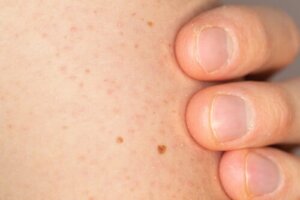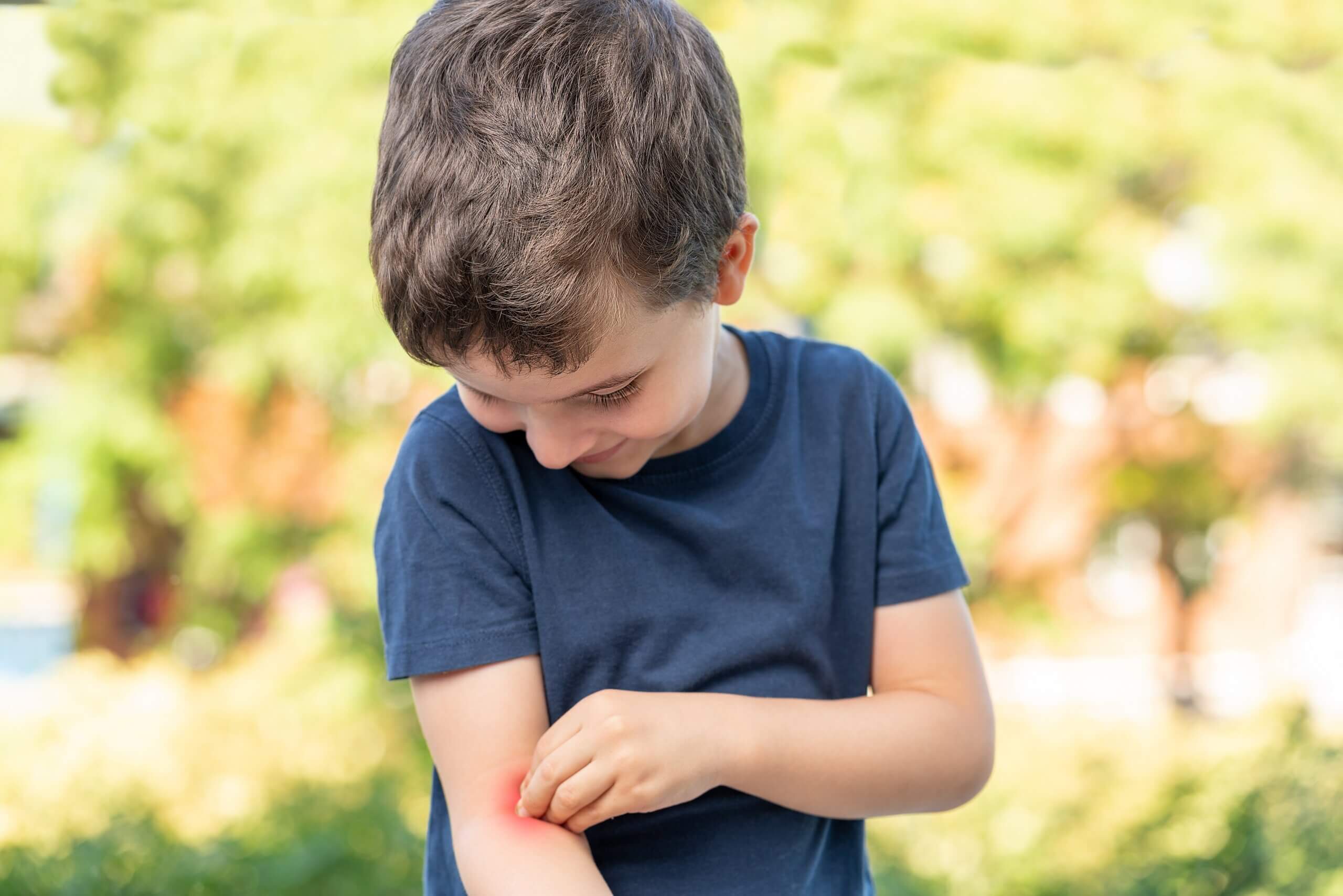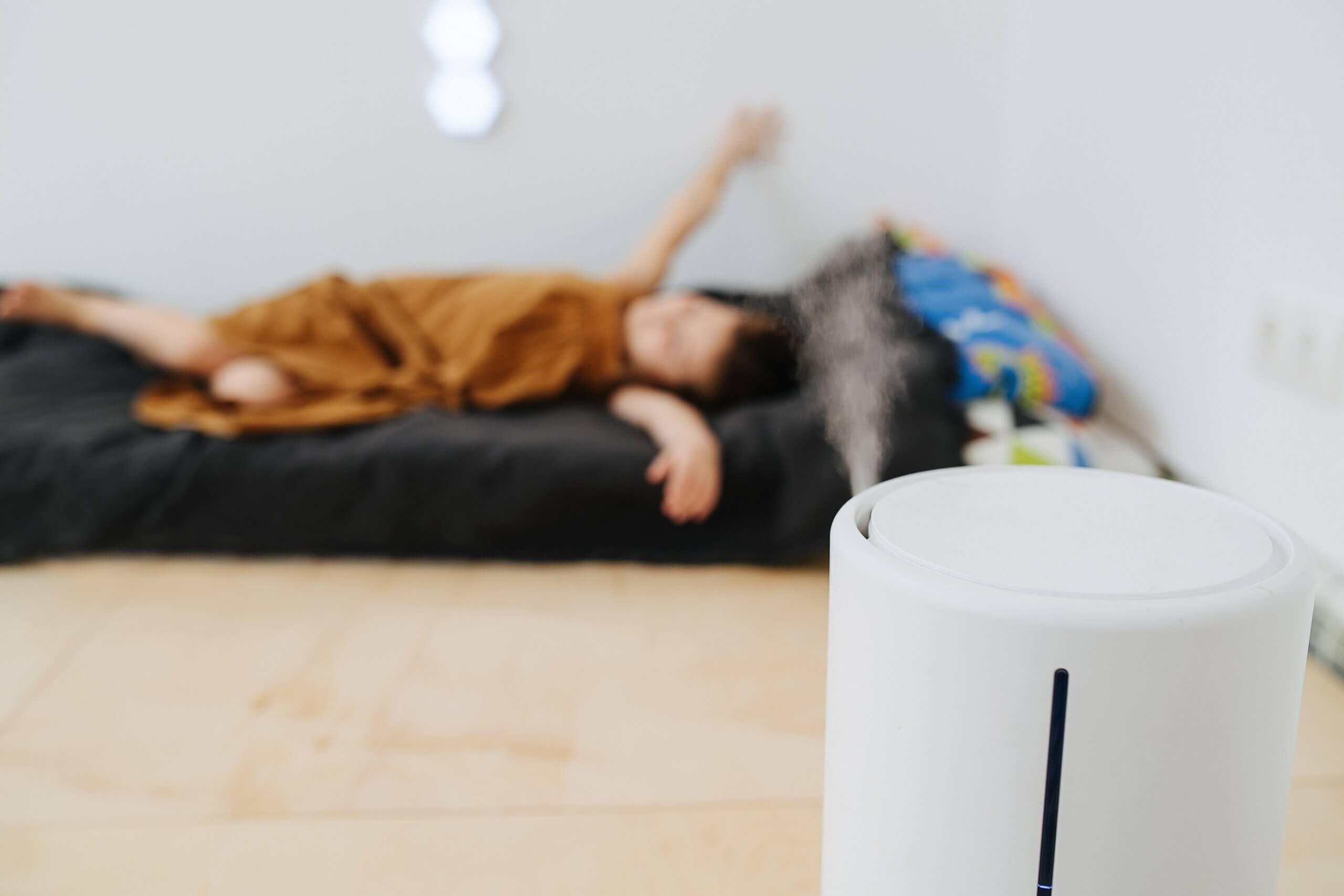How to Care for the Skin of Children with Keratosis Pilaris?


Written and verified by the dermatologist Maria del Carmen Hernandez
Keratosis pilaris is one of the most common dermatological conditions in children. In fact, it’s a benign skin manifestation that leads parents to consult their pediatrician. It’s a harmless genetic condition that usually disappears on its own before the age of 30. However, there are some measures to mitigate the appearance and care for the surface of the skin.
What is keratosis pilaris in children?
Keratosis pilaris is a common skin surface condition in children that appears in the form of plaques of tiny rough bumps on the posterior and lateral regions of the arms. In addition, they’re usually colored and arise as a result of clogging of the hair follicles with dead skin cells. Therefore, they appear on any region of the skin where there are openings through which hair grows, except on the palms of the hands or soles of the feet.
Clinical manifestations
The tiny lesions may extend beyond the arms and thighs. That is, they may appear on the calves and forearms. In turn, other symptoms that may be associated with keratosis pilaris include the following:
- Dry skin
- Protuberances that are similar to sandpaper
- Irritable and itchy skin
- Slight red or pink color around the lesions
While anyone can be susceptible to keratosis pilaris, it’s more common in children and adolescents. In fact, it usually appears in late childhood or during adolescence.
You may be interested in: Keratosis Pilaris in Children: Symptoms, Causes and Treatment

Caring for skin with keratosis pilaris in children
Although there’s no known specific cure for this skin condition, there are ways to relieve it and prevent it from worsening. In addition, it usually disappears after the age of 20, although in most cases, it resolves before the age of 30. Here are some care options.
Moisturize the skin constantly
One of the best measures to mitigate the appearance is to apply moisturizing cream on a daily and constant basis. In fact, moisturizing is one of the essential pillars to maintain functional and healthy skin.
Some of the most frequently recommended components of emollients are urea and lactic acid, as they help prevent dry skin. In addition, they help to loosen and remove surface and dead skin cells. It’s also important that the cream contains mild keratolytic components along with other anti-inflammatory and anti-irritant components that accelerate healing and evolution. Examples of these are the following:
- Bisabolol
- Glycolic acid
- Salicylic acid
Use exfoliating mittens
Exfoliation with vegetable sponges every day can help to improve the appearance of the skin surface. For this, it’s a good idea to cleanse the area with gentle, circular movements to remove dead skin. Although there are topical products that contain agents with strong properties for this purpose, the American Academy of Dermatology Association recommends the use of a loofah sponge when it comes to children.
Take short baths with lukewarm water
Bathing is one of the best times to take care of children’s skin. In addition, bathing with lukewarm water helps to unblock and free the hair follicle openings. However, it’s essential to limit the time in the water, as very long baths tend to remove natural oils and protectors from the body surface. In addition, after rinsing the skin, it should be dried very carefully. Ideally, this should be done by patting with a towel instead of rubbing.
Read also: Children with Skin Allergies: Symptoms and Recommendations

Place humidifiers in the child’s room
According to a publication by the American Osteopathic College of Dermatology, keratosis pilaris worsens during low humidity and cold winter months as the skin dries out. For this reason, the use of humidifiers also helps to maintain the skin’s own moisture and prevent itchy outbreaks. Experts even recommend ventilating the house every day to keep it cool in the summer and avoiding the use of too much heating during the cold season.
Choose the right clothing
Wearing clothes that are too tight can cause friction on the skin, resulting in irritation of the area. It’s also advisable to avoid wearing clothing made of wool or synthetic fibers that may cause dermatitis or irritation.
In some cases, when inflammation and irritation are very evident, the use of topical creams with low potency corticosteroids, as well as retinoids or derivatives thereof, may be prescribed by the child’s pediatrician or dermatologist.
Moisturizing is the most important thing for healthy skin
Keratosis pilaris is a condition that doesn’t usually present symptoms and improves with time. Therefore, there’s no need to implement treatment for the lesions it produces. However, care and hygiene habits play an important role in preventing excessive dryness and keeping the skin moisturized.
Keratosis pilaris is one of the most common dermatological conditions in children. In fact, it’s a benign skin manifestation that leads parents to consult their pediatrician. It’s a harmless genetic condition that usually disappears on its own before the age of 30. However, there are some measures to mitigate the appearance and care for the surface of the skin.
What is keratosis pilaris in children?
Keratosis pilaris is a common skin surface condition in children that appears in the form of plaques of tiny rough bumps on the posterior and lateral regions of the arms. In addition, they’re usually colored and arise as a result of clogging of the hair follicles with dead skin cells. Therefore, they appear on any region of the skin where there are openings through which hair grows, except on the palms of the hands or soles of the feet.
Clinical manifestations
The tiny lesions may extend beyond the arms and thighs. That is, they may appear on the calves and forearms. In turn, other symptoms that may be associated with keratosis pilaris include the following:
- Dry skin
- Protuberances that are similar to sandpaper
- Irritable and itchy skin
- Slight red or pink color around the lesions
While anyone can be susceptible to keratosis pilaris, it’s more common in children and adolescents. In fact, it usually appears in late childhood or during adolescence.
You may be interested in: Keratosis Pilaris in Children: Symptoms, Causes and Treatment

Caring for skin with keratosis pilaris in children
Although there’s no known specific cure for this skin condition, there are ways to relieve it and prevent it from worsening. In addition, it usually disappears after the age of 20, although in most cases, it resolves before the age of 30. Here are some care options.
Moisturize the skin constantly
One of the best measures to mitigate the appearance is to apply moisturizing cream on a daily and constant basis. In fact, moisturizing is one of the essential pillars to maintain functional and healthy skin.
Some of the most frequently recommended components of emollients are urea and lactic acid, as they help prevent dry skin. In addition, they help to loosen and remove surface and dead skin cells. It’s also important that the cream contains mild keratolytic components along with other anti-inflammatory and anti-irritant components that accelerate healing and evolution. Examples of these are the following:
- Bisabolol
- Glycolic acid
- Salicylic acid
Use exfoliating mittens
Exfoliation with vegetable sponges every day can help to improve the appearance of the skin surface. For this, it’s a good idea to cleanse the area with gentle, circular movements to remove dead skin. Although there are topical products that contain agents with strong properties for this purpose, the American Academy of Dermatology Association recommends the use of a loofah sponge when it comes to children.
Take short baths with lukewarm water
Bathing is one of the best times to take care of children’s skin. In addition, bathing with lukewarm water helps to unblock and free the hair follicle openings. However, it’s essential to limit the time in the water, as very long baths tend to remove natural oils and protectors from the body surface. In addition, after rinsing the skin, it should be dried very carefully. Ideally, this should be done by patting with a towel instead of rubbing.
Read also: Children with Skin Allergies: Symptoms and Recommendations

Place humidifiers in the child’s room
According to a publication by the American Osteopathic College of Dermatology, keratosis pilaris worsens during low humidity and cold winter months as the skin dries out. For this reason, the use of humidifiers also helps to maintain the skin’s own moisture and prevent itchy outbreaks. Experts even recommend ventilating the house every day to keep it cool in the summer and avoiding the use of too much heating during the cold season.
Choose the right clothing
Wearing clothes that are too tight can cause friction on the skin, resulting in irritation of the area. It’s also advisable to avoid wearing clothing made of wool or synthetic fibers that may cause dermatitis or irritation.
In some cases, when inflammation and irritation are very evident, the use of topical creams with low potency corticosteroids, as well as retinoids or derivatives thereof, may be prescribed by the child’s pediatrician or dermatologist.
Moisturizing is the most important thing for healthy skin
Keratosis pilaris is a condition that doesn’t usually present symptoms and improves with time. Therefore, there’s no need to implement treatment for the lesions it produces. However, care and hygiene habits play an important role in preventing excessive dryness and keeping the skin moisturized.
All cited sources were thoroughly reviewed by our team to ensure their quality, reliability, currency, and validity. The bibliography of this article was considered reliable and of academic or scientific accuracy.
- Keratosis Pilaris. [Internet]. Disponible en: https://www.aocd.org/page/KeratosisPilaris
- Kootiratrakarn, T., Kampirapap, K., & Chunhasewee, C. (2015). Epidermal permeability barrier in the treatment of keratosis pilaris. Dermatology research and practice, 2015, 205012. https://doi.org/10.1155/2015/205012
- Keratosis pilaris: Diagnosis and treatment. [Internet]. Disponible en: https://www.aad.org/public/diseases/a-z/keratosis-pilaris-treatment
This text is provided for informational purposes only and does not replace consultation with a professional. If in doubt, consult your specialist.








